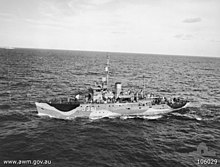HMAS Cowra (J351/M351), named for the town of Cowra, New South Wales, was one of 60 Bathurst-class corvettes constructed during World War II, and one of 36 initially manned and commissioned solely by the Royal Australian Navy (RAN).[1]
Design and construction

In 1938, the Australian Commonwealth Naval Board (ACNB) identified the need for a general purpose 'local defence vessel' capable of both anti-submarine and mine-warfare duties, while easy to construct and operate.[2][3] The vessel was initially envisaged as having a displacement of approximately 500 tons, a speed of at least 10 knots (19 km/h; 12 mph), and a range of 2,000 nautical miles (3,700 km; 2,300 mi)[4] The opportunity to build a prototype in the place of a cancelled Bar-class boom defence vessel saw the proposed design increased to a 680-ton vessel, with a 15.5 knots (28.7 km/h; 17.8 mph) top speed, and a range of 2,850 nautical miles (5,280 km; 3,280 mi), armed with a 4-inch gun, equipped with asdic, and able to fitted with either depth charges or minesweeping equipment depending on the planned operations: although closer in size to a sloop than a local defence vessel, the resulting increased capabilities were accepted due to advantages over British-designed mine warfare and anti-submarine vessels.[2][5] Construction of the prototype HMAS Kangaroo did not go ahead, but the plans were retained.[6] The need for locally built 'all-rounder' vessels at the start of World War II saw the "Australian Minesweepers" (designated as such to hide their anti-submarine capability, but popularly referred to as "corvettes") approved in September 1939, with 60 constructed during the course of the war: 36 (including Cowra) ordered by the RAN, 20 ordered by the British Admiralty but manned and commissioned as RAN vessels, and 4 for the Royal Indian Navy.[2][7][8][9][1]
Cowra was laid down by Poole & Steel at Balmain, New South Wales on 12 August 1942.[1] She was launched on 27 May 1943 by the wife of Percy Spender, the Federal Treasurer and member of the Advisory War Council, and was commissioned into the RAN on 8 October 1943.[1]
Operational history
Cowra began active service in November 1943 as a convoy escort along the east coast of Australia.[1] She continued until March 1944, when she was reassigned to New Guinea as an escort and anti-submarine patrol vessel.[1] In June 1944, the corvette sailed to Melbourne for refits, which concluded on 19 August.[1] She returned to New Guinea at the end of the month, and for the next eleven months was primarily assigned to escort and patrol duties near Morotai.[1] In January 1945, Cowra fired on Japanese shore positions at Yalela Bay, before visiting Brisbane briefly in February 1945.[1] On 17 July, she was recalled to Australian waters, where she spent the rest of World War II.[1] The ship was awarded two battle honours—"Pacific 1943–45" and "New Guinea 1944"—for her wartime service.[10][11]
Following the end of the war, Cowra was assigned to the 20th Minesweeping Flotilla, and performed mine clearance operations in the waters of Australia, New Guinea, and the Solomon Islands.[1] On 2 December 1946, Cowra returned to Sydney and was decommissioned into reserve.[1]
On 20 February 1951, Cowra was recommissioned for use as a training ship for National Service trainees.[1]
Decommissioning and fate
Cowra was paid off for the second time on 26 June 1953.[1] In January 1961, the corvette was sold to the Kinoshita Company of Japan for scrapping.
A memorial to the ship located outside the Cowra Services Club was dedicated on 15 March 2006.[12]
Citations
- ^ a b c d e f g h i j k l m n "HMAS Cowra". HMA Ship Histories. Sea Power Centre – Royal Australian Navy. Retrieved 23 December 2008.
- ^ a b c Stevens, The Australian Corvettes, p. 1
- ^ Stevens, A Critical Vulnerability, p. 103
- ^ Stevens, A Critical Vulnerability, pp. 103–4
- ^ Stevens, A Critical Vulnerability, pp. 103–5
- ^ Stevens, A Critical Vulnerability, p. 104
- ^ Stevens, A Critical Vulnerability, pp. 105, 148
- ^ Donohue, From Empire Defence to the Long Haul, p. 29
- ^ Stevens et al., The Royal Australian Navy, p. 108
- ^ "Navy Marks 109th Birthday With Historic Changes To Battle Honours". Royal Australian Navy. 1 March 2010. Archived from the original on 13 June 2011. Retrieved 23 December 2012.
- ^ "Royal Australian Navy Ship/Unit Battle Honours" (PDF). Royal Australian Navy. 1 March 2010. Archived from the original (PDF) on 14 June 2011. Retrieved 23 December 2012.
- ^ "HMAS Cowra Memorial". New South Wales War Memorials Register. New South Wales Government. 11 April 2012. Retrieved 3 January 2022.
References
- Books
- Donohue, Hector (October 1996). From Empire Defence to the Long Haul: post-war defence policy and its impact on naval force structure planning 1945–1955. Papers in Australian Maritime Affairs. Vol. 1. Canberra: Sea Power Centre. ISBN 0-642-25907-0. ISSN 1327-5658. OCLC 36817771.
- Stevens, David (2005). A Critical Vulnerability: the impact of the submarine threat on Australia's maritime defense 1915–1954. Papers in Australian Maritime Affairs. Vol. 15. Canberra: Sea Power Centre Australia. ISBN 0-642-29625-1. ISSN 1327-5658. OCLC 62548623.
- Stevens, David; Sears, Jason; Goldrick, James; Cooper, Alastair; Jones, Peter; Spurling, Kathryn (2001). Stevens, David (ed.). The Royal Australian Navy. The Australian Centenary History of Defence (vol III). South Melbourne, VIC: Oxford University Press. ISBN 0-19-554116-2. OCLC 50418095.
- Journal and news articles
- Stevens, David (May 2010). "The Australian Corvettes" (PDF). Hindsight (Semaphore). 2010 (5). Sea Power Centre – Australia. Archived from the original (PDF) on 20 March 2011. Retrieved 13 August 2010.
External links


Recent Comments